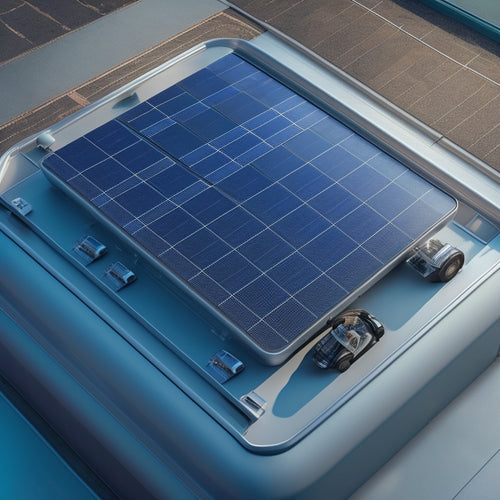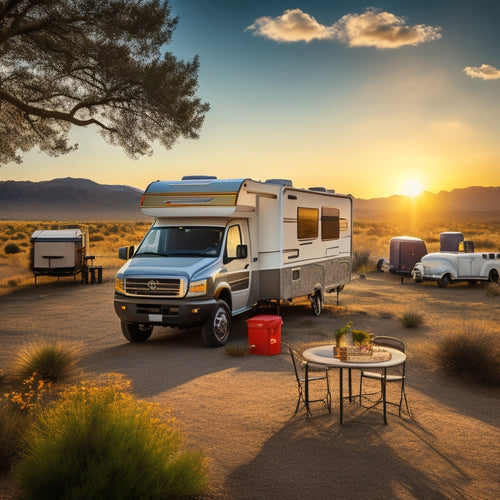
What Size Solar Panel System Do You Need?
Share
You need a solar panel system that's tailored to your unique energy needs, which requires a thorough understanding of your daily energy consumption, roof's potential, and local solar irradiance. Evaluate your energy usage patterns, assess your roof's orientation and size, and consider local solar irradiance to determine the ideal system size. Avoid oversizing, which can lead to wasted resources, and undersizing, which may not meet your energy demands. By carefully calculating your energy needs and considering system complexity, you'll get a system that meets your energy goals. Now, learn how to balance your energy needs with your budget.
Key Takeaways
• Assess your daily energy needs in watt-hours (Wh) to determine the required system size and energy production.
• Evaluate your roof's potential by considering orientation, size, and shading to determine the suitable system size and installation.
• Calculate your average daily energy usage in kilowatt-hours (kWh) to identify patterns and determine the right system size for your needs.
• Consider factors like local solar irradiance, system efficiency, and energy storage to determine the ideal system capacity and complexity.
• Use online sizing calculators and consult with solar professionals to validate your calculations and ensure an accurately sized system.
Understanding Your Energy Needs
To determine the size of your solar panel system, you need to evaluate your daily energy requirements in watt-hours (Wh). This involves analyzing your energy usage patterns and identifying the appliances and devices that consume the most power. This is essential in understanding your energy needs and ensuring your solar panel system can meet them.
Conducting an energy audit helps you identify areas where energy is wasted and opportunities to improve your energy behavior. This involves tracking your energy consumption over a period, usually a year, to understand your energy usage patterns.
You can use tools like smart plugs or energy monitors to track the energy consumption of individual appliances.
Assessing Your Roof's Potential
Your roof's solar potential is a critical factor in determining the size and effectiveness of your solar panel system, and a thorough assessment involves evaluating its size, orientation, and shading characteristics. To accurately assess your roof's potential, you'll need to take into account the following factors:
| Roof Characteristic | Ideal Condition | Impact on Solar Potential |
|---|---|---|
| Roof Orientation | South-facing | Maximum energy production |
| Roof Size | Large, unobstructed areas | More space for solar panels |
| Shading Analysis | Minimal to no shading | Reduced energy production |
A south-facing roof with minimal shading and ample space is ideal for solar panels. However, if your roof doesn't meet these conditions, don't worry! You can still harness solar energy. A thorough assessment will help you determine the most suitable solar panel system size and configuration for your unique situation. By understanding your roof's limitations, you can maximize your energy production and minimize costs.
Calculating Your Energy Usage
Determine your average daily energy usage in kilowatt-hours (kWh) to size your solar panel system accurately. This step is vital in ensuring you install a system that meets your energy needs.
To calculate your energy usage, you'll need to review your past utility bills. Collect your bills from the past 12 months to get an accurate representation of your energy consumption. Add up the total kWh used each month and divide that number by 30 to get your daily average.
You can also consider conducting an energy audit to identify areas in your home where energy is being wasted. This will help you pinpoint opportunities to reduce your energy consumption before installing your solar panel system.
When reviewing your utility bills, look for patterns in your energy usage, such as peak usage during summer months or spikes in energy consumption during holidays. By understanding your energy usage patterns, you'll be able to determine the right size solar panel system for your needs.
Determining System Size Requirements
How many solar panels do you need to generate enough electricity to meet your daily energy needs? To determine the system size requirements, you'll need to take into account several factors.
First, you'll need to assess your energy usage patterns, taking into account your appliances, lighting, and other electrical devices. This will give you an idea of your total daily energy consumption in watt-hours (Wh).
Next, you'll need to take into consideration the system complexity, including the type and efficiency of the solar panels, the inverter's efficiency, and the energy storage capacity. Energy storage is important, as it allows you to store excess energy generated during the day for use during the night or on cloudy days.
To accurately determine your system size requirements, you'll need to take into account your energy usage patterns, the local solar irradiance, and the system's efficiency. You may need to consult with a solar panel professional to make sure you're getting the right system size for your specific needs.
Using Online Sizing Calculators
To guarantee, it's critical to online sizing calculators, such as those offered by the National Renewable Energy Laboratory (NREL) or other reputable providers, can streamline the system sizing process by walking you through a series of questions to gather essential data and crunching the numbers to provide a recommended system size. By using these calculators, you'll save time and effort, as they'll do the complex calculations for you.
However, it's critical to understand calculator limitations. These tools rely on assumptions and averages, which mightn't accurately reflect your specific situation. Be cautious when interpreting the results, and consider consulting with a solar professional to validate the recommendations.
Before selecting a calculator, read online reviews to find one that suits your needs. Look for reviews from reputable sources, such as solar industry websites or forums, to get an idea of the calculator's accuracy and user-friendliness. By doing your research, you'll find a reliable calculator that provides a solid starting point for your system sizing journey.
Factors Affecting System Sizing
When sizing a solar panel system, you'll need to take into account several key factors that impact the overall performance and efficiency of your system.
Two critical factors affecting system sizing are local electricity rates and roof size constraints, which can greatly influence the number of panels you can install and the amount of energy you can generate.
Local Electricity Rates
Your solar panel system's performance is greatly influenced by the local electricity rates in your area, which can vary greatly depending on your location and utility company. Understanding these rates is important in determining the size of your solar panel system.
You'll want to take into account the cost of electricity from your utility company, as well as any time-of-use pricing structures that may impact your energy usage. For instance, if you live in an area with high peak-hour rates, you may want to size your system to offset those peak hours.
To make informed decisions, utilize rate comparison tools to research and compare electricity rates in your area. These tools can help you identify the most cost-effective options and optimize your system's performance.
Roof Size Constraints
Moreover, it's important to assess these constraints early in the design process. You'll need to take into account the available roof space, considering any Roof Obstacles that might reduce the usable area. These obstacles can include skylights, vents, and chimneys, which can block sunlight or create shading issues.
Additionally, you should also evaluate the Structural Limitations of your roof. This includes the weight capacity, material, and age of your roof. You don't want to install a system that's too heavy for your roof, which could lead to structural damage or even collapse.
Furthermore, older roofs might require additional reinforcement or repairs before a solar panel system can be installed.
Importance of Accurate Sizing
Accurate sizing of a solar panel system is crucial because it directly impacts the system's overall performance, efficiency, and ultimately, your return on investment. An undersized system won't meet your energy needs, while an oversized system will be wasteful and costly. You want a system that's just right for your energy demands.
As you consider your solar panel system, remember that system complexity also plays a significant role in accurate sizing. The more complex your system, the more crucial accurate sizing becomes. You'll need to factor in variables like panel orientation, shading, and electrical load to guarantee peak performance.
Fortunately, industry sizing standards provide a framework for determining the ideal system size. By following these standards, you can ensure your system is tailored to your specific energy needs. Don't risk under- or over-sizing your system – take the time to get it right.
With accurate sizing, you'll enjoy maximum energy output, reduced energy bills, and a faster return on your investment.
How to Use Sizing Tools Effectively
To determine the ideal solar panel system size, you'll need to master the use of specialized sizing tools that consider your energy requirements, roof size, and local solar irradiance. These tools can help you identify the best system size for your specific needs, making sure you get the most out of your solar investment.
When using sizing tools, it's crucial to understand their limitations and potential biases. Look for tools that provide transparent calculations and take into account multiple factors, such as local weather patterns and shading effects. Be cautious of sizing shortcuts that oversimplify the process, as they may result in inaccurate outcomes. Instead, opt for tools that offer detailed, data-driven recommendations.
Before committing to a particular tool, read reviews from other users to get a sense of its accuracy and reliability. Compare the results from multiple tools to ensure you're gaining a thorough view of your energy needs.
Avoiding Oversizing and Undersizing
As you design your solar panel system, you'll want to make sure it's sized correctly to meet your energy needs. Oversizing can lead to wasted resources and higher upfront costs, while undersizing may not provide enough power to meet your energy efficiency goals.
Right-Sizing Your System
You risk wasting money and compromising performance if you don't determine the ideal system capacity for your solar panel system, so it's essential to find the right size for your specific needs.
Right-sizing your system guarantees you generate the amount of energy you need without overspending on unnecessary capacity. A system that's too large will increase your upfront costs without providing additional benefits, while an undersized system may not meet your energy demands.
To avoid these pitfalls, consider the system complexity and energy flexibility you require. Assess your energy usage patterns and identify the periods of highest demand. This will help you determine the best system size that balances your energy needs with your budget.
A properly sized system won't only save you money but also provide the energy flexibility you need to power your home or business efficiently. By taking the time to calculate your energy requirements accurately, you'll be able to reap the maximum benefits from your solar panel system.
Energy Efficiency Goals
Defining energy efficiency goals helps prevent oversizing, which can lead to wasted resources, and undersizing, which may result in unmet energy demands.
As you consider your solar panel system, think about your energy efficiency goals. Are you aiming to reduce your carbon footprint or achieve net zero energy status? Perhaps you want to power your entire home or just supplement your energy needs.
Whatever your goal, clearly defining it's crucial.
Sizing for Optimal Energy Harvesting
Your solar panel system's energy harvesting potential is directly tied to its size, which is why accurately sizing your system is essential for maximizing energy production.
As you consider the best size for your solar panel system, you'll want to think about your energy efficiency goals and how they align with your energy harvesting needs.
If you're looking to power a small home or cabin, a smaller system may suffice. However, if you're planning to power a larger home, farm, or even a solar farm, you'll need a larger system to meet your energy demands.
When sizing your system, consider your energy storage needs as well. If you want to store excess energy generated during the day for use during the night or on cloudy days, you'll need to factor in energy storage solutions, such as batteries.
A properly sized system won't only make sure you're generating enough energy but also storing it efficiently.
Frequently Asked Questions
Can I Install Solar Panels if I Have a Small Roof?
"Absence of evidence doesn't mean evidence of absence." Don't let a small roof hold you back! You can still harness solar power despite roof constraints and limited space - consider vertical or adjustable panels, or even a community solar program.
How Do I Know if My Roof Gets Enough Sunlight?
To determine if your roof gets enough sunlight, you'll need to assess your roof's orientation, perform a shading analysis, and consider the sun's path throughout the day, while also checking for obstructions and considering your roof's age.
Will Solar Panels Still Work on Cloudy Days?
You'll be happy to know that solar panels still work on cloudy days, albeit with reduced cloudy performance, producing about 10-20% of their maximum energy output, so you'll still generate some power, just not as much as on sunny days.
Can I Add More Panels to My System Later?
Imagine your solar panel system as a puzzle, easily expandable as your energy needs grow. Yes, you can add more panels later, seamlessly integrating them into your existing system through system upgrades and panel expansion.
Are Solar Panels Worth It if I Live in a Shaded Area?
If you live in a shaded area, you're wondering if solar panels are worth it. Consider shaded roof considerations, like trimming trees or using specialized panels, and explore shaded area solutions, such as microinverters or power optimizers, to maximize energy production.
Related Posts
-

Waterproofing Solar Panels for Vehicles: A Step-by-Step Guide
When waterproofing solar panels for your vehicle, start by evaluating your energy requirements and selecting the righ...
-

Top Solar Panels for Car Battery Maintenance
When selecting top solar panels for car battery maintenance, consider high-efficiency models with high wattage output...
-

What You Need to Know About RV Solar Maintenance
When you're out on the road, your RV's solar panel system is your lifeline. But without regular maintenance, you're l...


